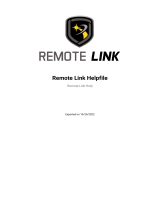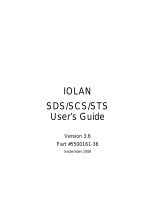
General Requirements
• All servers must be operating at all times including monitors.
• Do not use screen savers on any SCS-VR server.
• All servers must be connected to an uninterruptible power supply suitable for use with security systems.
• All servers must have a keyboard, mouse, monitor, and network connected. Refer to the manufacturer’s
instructions.
• The installation must provide supply line transient protection complying with the Standard for Transient Voltage
Surge Suppressors, UL1449, with a maximum marked rating of 330V.
• The source of power for the equipment shall be within the rated voltage range of the signal processing
equipment.
• The installation must provide supply line transient protection complying with the Standard for Protectors for Data
Communications and Fire Alarm Circuits, UL497B, with a maximum marked rating of 50V.
• The communication circuits and network components connected to the telecommunications network must be
protected by secondary protectors for communication circuits. These protectors must comply with the Standard
for Secondary Protectors for Communications Circuits, UL497A, with a marked rating of 150V or less. These
protectors must be used only in the protected side of the telecommunications network.
• All equipment must be installed in a temperature-controlled environment that can be maintained between
13-35°C (55-95°F) by the HVAC system. The environment shall also be maintained within the humidity range
rating of the equipment. Twenty-four hours of standby power must be provided for the HVAC system. The
standby power system for the HVAC system may be supplied by an engine driven generator alone. A standby
battery is not required to be used. A maintenance contract that provides for restoring operation of the HVAC
system within 24hours, 7days a week shall be in place.
• In addition to the 110/240VAC, 50/60Hz main and secondary power supplies that are required to be provided
at the central supervisory station, the system must also be provided with an uniterruptible power supply (UPS)
with sufficient capacity to operate the server equipment for a minimum of 15minutes. If more than 15 minutes is
required for the secondary power supply to supply the UPS input power, the UPS must be capable of providing
input power for at least that amount of time.
• UPS systems must comply with the Standard for Uninterruptible Power Supply Equipment, UL1778, or the
Standard for Fire Protective Signaling Devices, UL1481.
• In order to perform maintenance and repair service, a means for disconnecting the input to the UPS while
maintaining continuity of power to the automation system shall be provided.
• A polling error “non check-in message” alarm must be responded to as a compromise attempt by proper
authorities.
• The central station’s primary power supply is monitored for AC loss. A tamper switch is also provided to monitor
the control unit’s front cover removal. For either condition, a change of status display occurs at the central station.
• Equipment must be installed within a locked room or a locked rack provided with a tamper switch.
• A power conditioner used with the system shall comply with the applicable requirements in the Standard for
Power Units Other Than Class 2, UL1012.
• All equipment connected to the signal processing equipment must be located in the same room as the signal
processing equipment.
• All equipment must be self-contained in a rack with means for connection to the branch circuit supply which
includes installing the supply conductors in conduit.
• The self-contained rack with the SCS-VR servers shall also have speakers for audible annunciation for local
operation and must be located in proximity of the supervising station for operator interface.
• All interconnected equipment used in conjunction with the SCS-VR or SQL servers such as monitor, keyboard, and
mouse must not have cabling exceeding 8feet in length.
California State Fire Marshall Listing
SCS-VR is approved by the California State Fire Marshall (CSFM) for fire installations. Refer to Listing No. 7168-1157:0133.
256-bit AES Encryption
The SCS-VR virtual receiver, version 1.4.0 or higher, supports the 256-bit AES encryption option for XR550E control
panels using version104 or higher software. SCS-VR supports both the new 256-bit option and 128-bit to maintain
compatibility with exiting control panels. Either 128-bit or 256-bit encryption can be enabled in panel programming for
NET or CELL communication paths. Once enabled in the panel, SCS-VR automatically communicates with that panel
using the appropriate encryption. Refer to Listing NIST AES Algorithm Certificate #3027 256-bit.
To support AES Encryption, Java Cryptography Extension (JCE) must be deployed.
2 SCS-VR INSTALLATION SETUP GUIDE
























